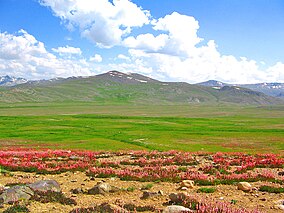Deosai National Park: Difference between revisions
No edit summary Tags: Mobile edit Mobile web edit |
Anchan Balti (talk | contribs) mNo edit summary |
||
| Line 19: | Line 19: | ||
| visitation_num = |
| visitation_num = |
||
| visitation_year = |
| visitation_year = |
||
| governing_body = |
| governing_body = Directorate of Deosai National Park Sadpara Road Skardu |
||
| world_heritage_site = |
| world_heritage_site = |
||
| url = |
| url = |
||
| website = [http://www.skardu.pk www.skardu.pk] |
|||
}} |
}} |
||
[[File:EnteringAEntrance_of_Deosai_National_Park.jpg|Entrance of Deosai National Park, Skardu.]] |
[[File:EnteringAEntrance_of_Deosai_National_Park.jpg|Entrance of Deosai National Park, Skardu.]] |
||
Revision as of 08:47, 1 October 2015
| Deosai National Park | |
|---|---|
| Ghbyarsa "غبیارسہ " | |
 The blooming Deosai Plains, Deosai National Park. | |
 | |
| Location | Skardu Gilgit Baltistan Pakistan |
| Nearest city | Skardu |
| Area | 3,000 km2 (1,200 sq mi) |
| Established | 1993 |
| Governing body | Directorate of Deosai National Park Sadpara Road Skardu |
| Website | www.skardu.pk |
Entrance of Deosai National Park, Skardu.



The Deosai National Park is located in between Skardu, Gultari, Kharmang and Astore Valley , in northern Pakistan.
Etymology
In Urdu language Deosai Urdu "دیوسای٘" means 'the land of Giants'.It is locally called غبیارسہGhbiarsa by Balti people because it is only accessible in summer.
Geography
Deosai National Park is at an average elevation of 4,114 metres (13,497 ft) above sea level, making the Deosai Plains one of the highest plateaus in the world. The park protects an area of 3,000 square kilometres (1,200 sq mi). It is well known for its rich flora and fauna of the Karakoram-West Tibetan Plateau alpine steppe ecoregion. In the Spring season it is covered by sweeps of wildflowers and a wide variety of butterflies
How to reach there
Deosai is accessible from Skardu District in the north, Gultari Kharmang district in the south-east, and the Astore District in the west. Deosai is located approximately 30 km from Skardu city and its the shortest route to visit Deosai. Most foreigners visit deosai via Skardu. It takes 1 hour to reach Deosai top via Sadpara Skardu. Another route is from Astore valley via Chilim. It is also accessible from Shila valley. The people of Gultari travel via Deosai. There is another route called Burgi la via Tsoq Kachura valley Skardu.
Sheosar Lake
Deosai Lake, or Sheosar Lake from the Shina language[citation needed] meaning "Blind lake" (Sheo - Blind, Sar - lake) [citation needed] is in the park. The lake, at an elevation of 4,142 metres (13,589 ft), is one of the highest lakes in the world. Its length is 2.3 kilometres (7,500 ft), width 1.8 kilometres (5,900 ft) and average depth 40 metres (130 ft).
Wildlife
The Deosai National Park was established in 1993 to protect the survival of the Himalayan brown bear and its habitat. Having long been a prize kill for poachers and hunters, the bear now has a hope for survival in Deosai where its number has increased from only 19 in 1993 to 40 in 2005. During the last decade, a few but effective measures have been taken by the Government of Pakistan (Deosai is completely located in Pakistan ) for the survival of brown bear in the region. In 1993, Himalayan Wildlife Project was founded with a substantial financial support from international environmental concerns. But the brown bear is still under threat.
The Deosai Plains are also home to the Himalayan ibex, red fox, golden marmot locally called Phia, gray wolf, the Ladakh urial, the snow leopard, and over 124 resident and migratory birds. Birds in the park include the golden eagle, lammergeier, griffon vulture, laggar falcon, peregrine falcon, kestrel, sparrowhawk and snowcock.
Cultural references
Herodotus
Research by the French ethnologist Michel Peissel makes a claim that the story of 'Gold-digging ants' reported by the Greek historian Herodotus, who lived in the 5th century BC, was founded on the golden Himalayan Marmot of the Deosai plateau and the habit of local tribes such as the Minaro to collect the gold dust excavated from their burrows.[1]
In film
The documentary film series Land of the Tiger, in episode 5 - the "Mountains of the Gods", features the plants and animals of Deosai. Karakoram Heli skying 2013 by Walkabout Films. Documentary movie "Deosai the last sanctuary"
See also
References
- ^ Peissel, Michel. "The Ants' Gold: The Discovery of the Greek El Dorado in the Himalayas". Collins, 1984. ISBN 978-0-00-272514-9.


